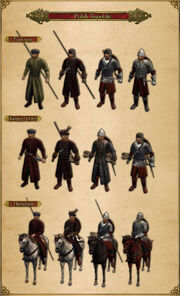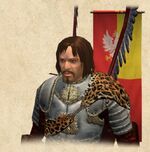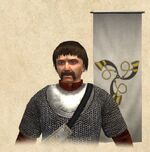The Polish Commonwealth is a nation in Eastern Europe.
Also known as the Polish-Lithuanian Commonwealth, its population is made up of three major groups: Poles, Ruthenians (ancestors of Ukrainians and Belarusians), and Lithuanians. The minority groups were non-Lithuanian Balts and Jews. The Polish Commonwealth is famed for its majestic Winged Hussars. While it possesses a powerful army, it is fragile due to its dissatisfied gentry, which could ultimately lead to the Polish Commonwealth's demise.
The Polish Commonwealth is led by King Jan Kasimir. Polish infantry does not lack in anything—their Zolniers and Pikemen are perfectly competent—but they don't really shine, being outgunned by Swedish musketeers and outfought by even Russian marksmen and their poleaxes. Poland's strength lies in its winged hussars, unmatched in both armor and shock value. Backed up with light dragoons, the Polish cavalry is devastating against infantry while posing a good match for even Crimean cavalry. It is located at the North-Middle to West part of the map.
The Deluge is the main questline for the Polish Commonwealth.
Rulers
Vassals
Tactics
Strengths
- Nearly unmatched heavy cavalry (the Winged Hussars).
- Okay dragoons and other light cavalry.
- Sturdy pikemen and zolniers who can stop enemy cavalry.
Weaknesses
- No heavy and shock infantry.
- Weak infantry will get slaughtered in any significant melee.
- Unreliable horse archers.
Troop tree

| Town Recruits | Mercenary Camp | Village Recruits |
|
Garrison Commander Infantry Commander Cavalry Commander Heavy Infantry Commander Heavy Cavalry Commander Personal Guard Commander Mercenary Commander |
Infantry Marksman Cavalry |
Territories
The territory of the Polish Commonwealth starts with the following Towns, Fortresses, and Villages.
| Territory of the Polish Commonwealth |
|---|
| Towns Krakov • Lviv • Smolensk • Vilna • Warsaw |
| Fortresses Bar Fortress • Berestye Fortress • Dubensk Castle • Kovno Fortress • Lida Castle • Lodz Castle Lublin • Minsk • Myadzelsk Castle • Polotsk • Slutsk • Zbarazh Fortress |
| Villages Amere • Babice • Baranovichi • Chenstokhova • Dobrush • Ilyintsy • Krivichi • Ludinovo Molodechno • Nesvizh • Ostroleka • Ostrovets • Ovruch • Plotsk • Ponyri • Radzilow • Rudnya Sambir • Slavuta • Snechko • Sofronovo • Solechniki • Staronowice • Stryi • Trakai • Vendau Vydzy • Wadowice • Widawa • Yartsy • Zamoshye |
Trivia
- The Polish Commonwealth's full name was The Kingdom of Poland and the Grand Duchy of Lithuania, but it was often shortened to the Polish–Lithuanian Commonwealth.
- The Polish Commonwealth was a dualistic state of Poland and Lithuania ruled by a common monarch.
- It was the largest and one of the most populous countries of 16th and 17th century Europe, with almost 400,000 square miles (1,000,000 square kilometers) and a multi-ethnic population of about 12 million at its peak in the early 17th century.
- The Commonwealth was established at the Union of Lublin in July 1569 and ceased to exist as an independent state after the Third Partition of Poland in 1795.
- Although the two component states of the Commonwealth were formally equal, Poland dominated in the partnership - as the King of Poland was always the Grand Duke of Lithuania at the same time.
- The Polish Commonwealth achieved its maximum territorial extent in 1619. It terms of present-day borders, it encompassed: most of Poland and Ukraine; all of Belarus, Lithuania, Latvia and the Kaliningrad Oblast; much of Estonia; parts of Russia (including Smoleńsk); as well as small parts of Moldova and Romania.

|
Wikipedia has an article on this subject at: Polish–Lithuanian Commonwealth |
| Classic/Warband Factions |
|---|
| Khergits • Nords • Rhodoks • Sarranids • Swadians • Vaegirs |
| With Fire & Sword Nations |
|---|
| Cossacks • Crimeans • Muscovites • Polish • Swedes |
| Napoleonic Wars Nations |
|---|
| Austria • France • Prussia • Rheinbund • Russia • United Kingdom |
| Viking Conquest Factions |
|---|
| Cultures Angles • Britons • Friese • Gaels • Norsemen • Picts • Saxons |
| Factions Aileach • Alban • Alt Clut • Brycheiniog • Connachta • Cornubia • Danmark • East Engle • Friese Glywyssing • Gwynedd • Laigin • Laithlind • Mide • Mierce • Mumain • Northhymbre • Northvegr Osraige • Uladh • West Seaxe |






























